Sarah Sundin's Blog, page 141
March 9, 2022
Today in World War II History—March 9, 1942

Men of Japanese 2nd Division celebrating landing at Merak, Java, 1 Mar 1942 (Sectie Militaire Geschiedenes Landmachstaf, public domain)
80 Years Ago—Mar. 9, 1942: Japanese complete conquest of Java and gain control of entire Netherlands East Indies.
US Office of Chief of Cavalry is eliminated, with troops in cavalry units to be transferred to armored units (but 2nd Cavalry Division remains mounted until January 1944).
The post Today in World War II History—March 9, 1942 first appeared on Sarah Sundin.March 8, 2022
Make It Do – Clothing in World War II

During World War II, the United States didn’t ration clothing as the United Kingdom and many other nations did, but restrictions were applied, and fashions adapted to use less fabric.
Why Clothing?Eleven million men and women served in the US military during the war, and they all needed uniforms. This strained the country’s supply of fabric, particularly wool, and the garment manufacturing system. Since Japan produced the majority of the world’s silk, the war cut off the supply completely. Civilians were encouraged to purchase or make clothing from cotton, rayon, or rayon/wool blends.
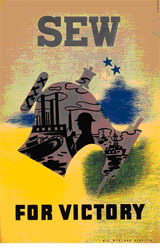
US “Sew for Victory” poster, World War II
Wartime Women’s FashionsClothing using less fabric became fashionable. Women’s suits took on a sleek, military look. Suit jackets were fitted, with padded shoulders, and rested between the waist and hip. Skirts rose to knee-length and took on a slim silhouette, often with an A-line flare. The peasant look was also popular, but without full skirts and ruffles. Also, millions of women entering the workplace popularized the “Rosie the Riveter” look—slacks became stylish, as well as turbans, snoods, and headscarves to keep hair away from machinery. Since metal zippers were unavailable, wraparound dresses and skirts were introduced. See my 1940s Fashions Pinterest board for lots of pictures.
Wartime Men’s FashionsBefore the war, when a man purchased a suit, it came with a jacket, a vest, and two pairs of trousers. The wartime “Victory Suit” eliminated the vest and second pair of trousers. Men’s jackets were single-breasted, had narrow lapels, no cuffs, and no pocket flaps. Wartime necessity allowed men to wear mismatched jackets and trousers.
War Production Board Restrictions
“WPB Yardstick” poster showing War Production Board standards for women’s clothing under order L-85, 8 March 1942
On March 8, 1942, the US War Production Board (WPB) issued order L-85 with the goal of 15 percent reduction in the amount of textiles used in women’s wear. Skirt length and width were restricted, as well as the width of women’s slacks. The WPB prohibited pleats, ruffles, patch pockets, attached hoods and shawls, and full sleeves or skirts. Hems and fabric belts could be no wider than two inches, and garments could have no more than one pocket. Exemptions were allowed for bridal gowns, maternity clothes, and religious vestments.

US poster encouraging knitting, WWII
Home sewing and knitting were not restricted and became even more popular. However, patterns of the time tended to follow WPB guidelines.
Price ControlsThe textile situation worsened in 1944. Manufacturing of civilian clothing fell 50 percent, and prices began to rise. To prevent rampant inflation, the Office of Price Administration instituted price controls on clothing on March 19, 1945, which were lifted on August 18, 1945.
Making Do
US poster urging mending clothes, 1943
Mending was more than economical, it was a patriotic duty, and a fad for patched clothing emerged. Home sewers often pieced together garments from remnants, mixing and matching colors and patterns. Creative women cut down old garments to reuse the cloth and remade old clothing into wartime fashions. Due to the silk shortage, women shared wedding dresses and formalwear. With so many men off to war, wives were encouraged to remake their husband’s suits for their own use, and the old pioneer tradition of cutting down adult clothing for children’s use returned.
Shoes and StockingsDuring World War II, the United States rationed leather shoes (see Make It Do – Shoe Rationing in World War II), and silk and nylon stockings were scarce (see Make It Do – Stocking Shortages in World War II).
What do you think of 1940s fashions? Would you have resented the restrictions or enjoyed the chance to be creative?
The post Make It Do – Clothing in World War II first appeared on Sarah Sundin.Today in World War II History—March 8, 1942
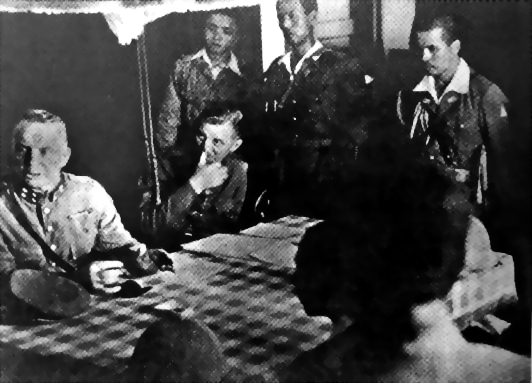
Hein ter Poorten surrendering to the Japanese, Kalidjati, Java, Dutch East Indies, 8 Mar 1942 (public domain via WW2 Database)
80 Years Ago—Mar. 8, 1942: On Java, Governor-General of the Netherlands East Indies surrenders to Japanese; 60,000 POWs.
Japanese land on New Guinea at Lae and Salamaua.
US War Production Board places restrictions on women’s clothing to save 15% of yardage, with exemptions for bridal and maternity clothes (Read more: Make It Do—Clothing in World War II).
The post Today in World War II History—March 8, 1942 first appeared on Sarah Sundin.March 7, 2022
Today in World War II History—March 7, 1942

Maj James A. Ellison reviews first class of Tuskegee Airmen, returning the salute of Mac Ross, one of the first graduates, Tuskegee Army Air Field, AL, 1941 (US Air Force photo)
80 Years Ago—Mar. 7, 1942: Japanese occupy Rangoon, Burma.
First African-American flying cadets graduate at Tuskegee Army Air Field, AL.
The post Today in World War II History—March 7, 1942 first appeared on Sarah Sundin.March 6, 2022
Today in World War II History—March 6, 1942
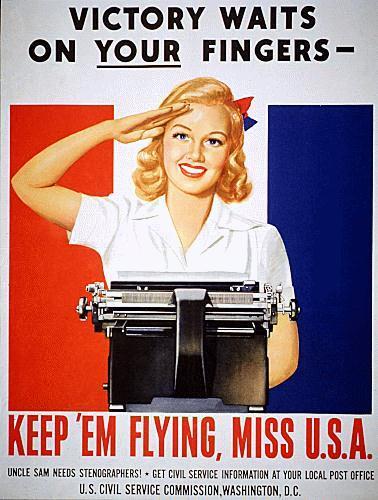
US poster, WWII
80 Years Ago—Mar. 6, 1942: US Gen. Joseph Stilwell meets with Chiang Kai-shek for first time in Chungking.
Typewriters are rationed in US; sales of new and used typewriters are banned (Read more: “Make It Do – Metal Shortages in World War II”).
Movie premiere of To Be or Not To Be, starring Jack Benny and Carole Lombard in her last role.
The post Today in World War II History—March 6, 1942 first appeared on Sarah Sundin.March 5, 2022
Today in World War II History—March 5, 1942
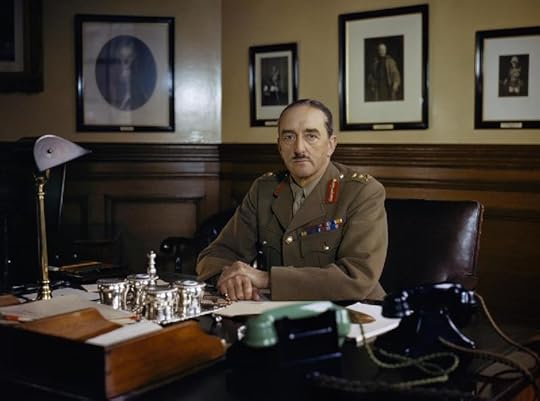
Gen. Sir Alan Brooke, Chief of General Staff, at his desk in the War Office in London, 1942 (Imperial War Museum: TR 151)
80 Years Ago—Mar. 5, 1942: Gen. Sir Alan Brooke becomes chairman of British Chiefs of Staff, in addition to his position as Chief of Imperial General Staff.
British expand conscription to men 41-45 and women 20-30.
First Naval Construction Battalion is established and officially nicknamed “Seabees.”
US Civil Air Patrol begins antisubmarine patrols on East Coast; base established at Rehoboth, DE.
Dmitri Shostakovich’s Seventh Symphony premieres at the Bolshoi Theater, inspired by his experiences in the siege of Leningrad.
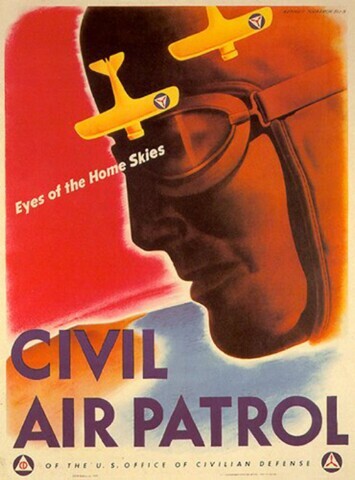
Poster of the US Civil Air Patrol, WWII
The post Today in World War II History—March 5, 1942 first appeared on Sarah Sundin.March 4, 2022
Today in World War II History—March 4, 1942

SBD-3 Dauntless dive-bombers prepare for launch from carrier USS Enterprise, early 1942 (US National Archives)
80 Years Ago—Mar. 4, 1942: Two Japanese H8K flying boats bomb Pearl Harbor—no damage.
Aircraft from USS Enterprise strike Marcus Island in South Pacific.
The post Today in World War II History—March 4, 1942 first appeared on Sarah Sundin.March 3, 2022
Today in World War II History—March 3, 1942

Lancaster B Mark Is of No. 44 Squadron, Royal Air Force, 29 September 1942 (Imperial War Museum: TR 197)
80 Years Ago—Mar. 3, 1942: Operational debut of RAF Avro Lancaster heavy bomber, in a minelaying operation off Helgoland.
Japanese bomb Broome, Australia; 88 killed including Dutch evacuees and US airmen just evacuated from Java.
The post Today in World War II History—March 3, 1942 first appeared on Sarah Sundin.March 2, 2022
Today in World War II History—March 2, 1942
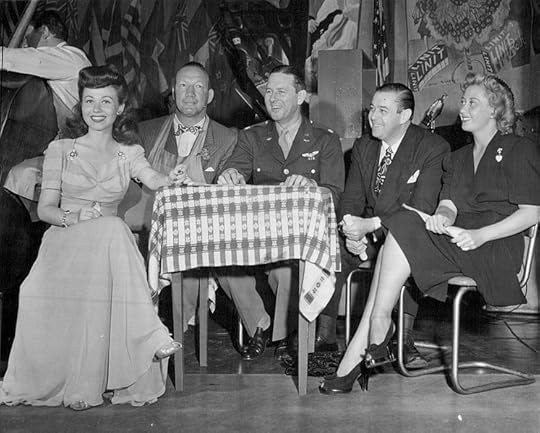
Connie Haines, Maxie Rosenbloom, Ben Lyon, Morton Downey and Joan Blondell at the Stage Door Canteen in New York, 20 August 1943 (public domain via Wide World Photos)
80 Years Ago—Mar. 2, 1942: In Australia, all adult civilians are liable for compulsory war service.
US Army reorganizes into three autonomous commands—Ground Forces, Army Air Forces, and Services of Supply.
Stage Door Canteen opens on Broadway in 44th St. Theater, where stars entertain and serve servicemen.
The post Today in World War II History—March 2, 1942 first appeared on Sarah Sundin.March 1, 2022
Today in World War II History—March 1, 1942

HMS Exeter under attack during the Battle of the Java Sea, 1 Mar 1942 (Japanese Navy Photo, public domain)
80 Years Ago—Mar. 1, 1942: In the Battle of Sunda Strait off Java, Japanese ships sink heavy cruiser USS Houston, light cruiser HMAS Perth, and Dutch destroyer Evertsen; US ships sink five Japanese transports and other ships.
In the Battle of the Java Sea, Japanese cruisers sink heavy cruiser HMS Exeter and destroyers HMS Encounter and USS Pope.
Off Newfoundland, a PBO Hudson bomber sinks U-656, the first German U-boat sunk by the US Navy in WWII.
“Command Performance” radio show premieres from New York, starring Eddie Cantor taking requests from servicemen.
The post Today in World War II History—March 1, 1942 first appeared on Sarah Sundin.


